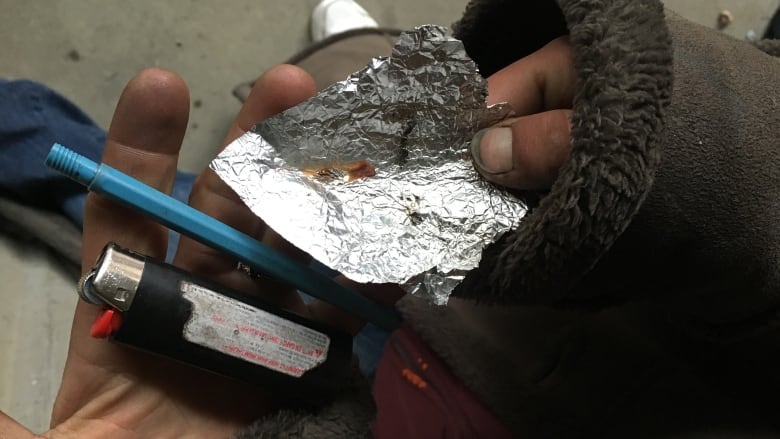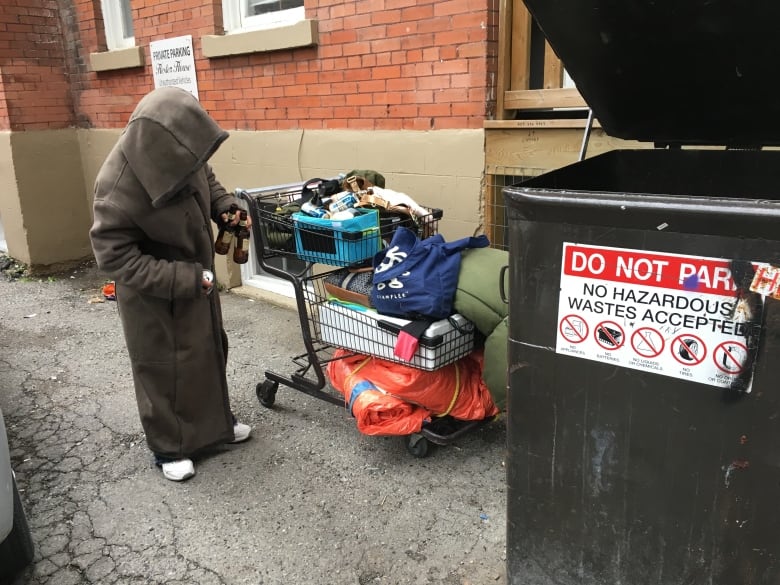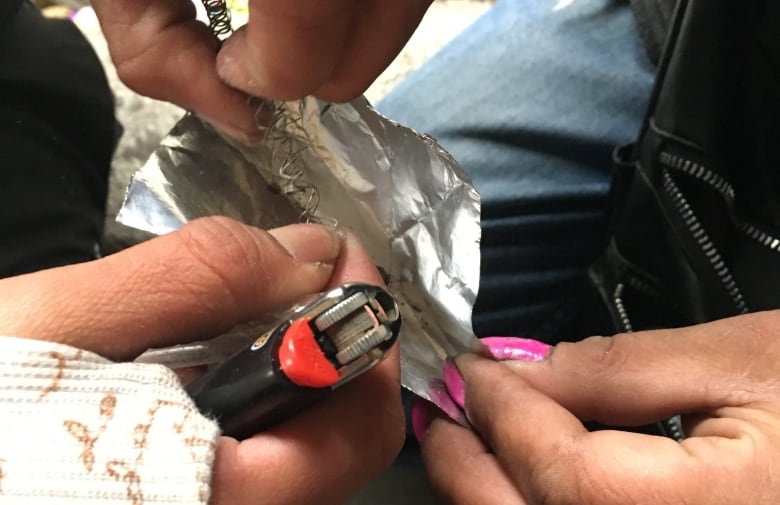40 minutes inside the fentanyl crisis
She used to be a carpenter; now her life revolves around the sickness'

There's a woman standing outside the acupuncture clinic in Calgary's Beltlineneighbourhood. She seems nervous or perhaps cold, which seems oddbecause she is wearing a luxuriousgreyish-brown, ankle-lengthsuede coatwith a hood.
It is mid-September, and the weather is still warm. Every now and then, the woman looks south, watching for someone, something.
"What are you waiting for?" I ask her.
"I'm waiting for my dope," she tells me.
Amanda, which is not her real name,usesfentanyl. It's anillicit drug that's at the heart of theopioidcrisis.
The synthetic painkiller is 100 timesmore potent than morphineand it's easy to overdose.
- This is the first instalment in a four-part series in conjunction with the Calgary Eyeopener about how the fentanyl crisis is affecting people in the city.
- Read the second instalment:On top of the grief, there's the shame: families of victims frustrated with stigma of opioid use
- Listen to Amanda's story on the Calgary Eyeopener
Hundreds of Albertans dieof accidental fentanyl poisoning every year:348 in 2016, 569 in 2017, and 330 in the first half of 2018.
I don't want to die but sometimes I don't want to live.- Amanda, a fentanyl user in Calgary
Amanda's shopping cart in the alley brims with empties that rattle noisily as she pushes it to a parking spot by a dumpster.
One "point" of fentanyl, equal to a 10thof a gram, costs Amanda $25. She smokes two grams a day.
To feed her habit, Amanda tells me she panhandles and collects bottles.
"I have quite a tolerance," she says.
Amanda is 30 years old. She once worked as a carpenter. She had a homeand a life.
Now, she lives for "the sickness," as she calls it.
"Some days I don't eat. That's kind of secondary to the sickness. Unfortunately, the sickness comes first."
It began when Amanda's car got T-boned in early January 2017. She spent five months in hospital with severe spinal injuries.
"They were giving me liquid fentanyl every two hours through my CV line in my neck, which goes directly to your heart," Amanda says.

She received numerous painkiller prescriptionsand developed a habit, but couldn't afford to pay for refills.
"That's how I really started doing fentanyl on the streets."
Being homeless is particularly dangerous for women, she tells me.
"Some of the most horrible experiences have happened to me this last year. I was raped a couple times. People don't care. They just think, hey, there goes that junkie. They don't know."
On the streets, fentanyl and other opiates are known as "down."
I ask Amanda why.
'It's like a relief'
"It brings you down. It's like a relief. It takes the sickness away. There's that relief, relief from the pain, right? Not only do I have mental and emotional pain, I have a lot of physical pain."
I want to know what her family says about her situation.
She's from Thunder Bay, Ont., and says she doesn't have much contact with her relatives.
"They don't really care, to be honest. The drug is great for that. It helps me forget about all that shit, too."
For a time she lived in a group home. She's been in and out of jail since her teens.
While she's waiting, Amanda chats with her friend Roger, who doesn't want to give his last name. Roger has used opiates for more than 30 years, but says he only started using fentanyl in the past couple of yearsbecause his dealer couldn't get him the opiate pill he was looking for.
"For two days he tried and tried and tried. He said, 'Rog, I'm so sorry. Like, you're in bad shape.' So he brought me back the fentanyl. He explained how powerful and deadly and dangerous it was. I says, 'I know, our friends are all gone. There's nobody left on the streets that was here in 2010. They're all dead.'"
Roger once worked in construction. He was a rodbuster, tying steel, and helped erect numerous buildings in the downtown core.
"I tied 16 floors on the Bow [Tower]," he says. "I'm a lead hand, so I've done a lot of work in Calgary."
Now, it's about the drug, and survival in face of the risks.
"I don't understand why [fentanyl]is on the street," he says.
"How is it out here, you know what I mean? It's probably the most powerful poison, and so accessible. Half a point is enough to kill. And it does, every day."
Fentanyl can be snorted, injected, swallowed as a pill, or smoked.
Amanda prefers to smoke the drug, instead of injecting it, to get away from dirty needlesthat carry the risk of HIV infection and other blood-borne diseases. It's in part the reason for needle exchanges and supervised consumption sites such as Safeworks, insidethe Sheldon Chumir Health Centre, just up the street from where Amanda, Roger and I are talking.
But Safeworks doesn't have the proper ventilation in place to accommodate users who prefer to smoke drugs, so Amanda does fentanyl on the streets. It means she doesn't get monitored after she uses, in case she overdoses, like thosewho use inside Safeworks.
The morning we spoke, one of her friends had died of an overdose from smoking fentanylnearthe supervised consumption site.
"They need to have a place for opiate addicts using this stuff, even to smoke it," she says.
I ask her if she is afraid of what could happen to her.
"Yes and no. I don't want to die, but " she trails off.
"Sometimes I don't want to live."
She hides her faceand Roger embraces her. The city buses are loudand I cannot hear her cry.
Amanda tells me she's tried to kick the habit before.
"It's really quite brutal to quit and stop. I've had to quit cold turkey from heroin and fentanyl is like heroin but stronger. It's a physical sickness, right? I have no control of my bowel, bladder;I get the shakes, sweats it feels like I'm dying. Sometimes I wish I was dead when I'm sick."
She's considering a methadone program, to reduce her opioid dependency, but isn't sure she'll be able to remember to pick up her medication at the pharmacy every day: "I lose track of time so easy."
I follow Amanda into an alley, then a parkade entrance, where she and a couple of other young women have gathered to take the drug.
One tells me she's from the Tsuut'ina First Nation. She is so quiet, so young. She can't be more than 16. She asks me if I've come to watch someone overdose. I reassure her this is not the case.
Amanda pulls out a small piece of barbecue tin foil, a lighter, and a plastic pen tube that she calls a "hooter."
The pen tube has a metal spring in it, to collect the fentanyl resin as they inhale it.

They will smoke the resin again later.
Amanda opens a tiny baggie, no bigger than a packet of sugar, containing a chalky pink powder. It's Magenta, a popular, strong strain of street fentanyl right now.
She puts some of the powder on the foil, flicks the lighter underneath it, and inhales deeply through the hooter. The smoke is white and I try not to breathe any in.
After they've taken a hit, the powder is burnt and brown on the foil. They re-light it again, smoke more. I look around self-consciously, but no one seems to even notice us there, clustered in a concrete corner.
Sisters
The women call each other "sister."
"People don't understand how the streets are," says the third woman, who doesn't tell me her name. "People just stand there and just talk about us, judge us. To us, when we lose somebody, it's more than just somebody. It's a family to us."
Amanda says she likes to get her drugs from the same dealers,"because I know where it's coming from and I know they're not messing around with it and trying to re-press it and it's not going to kill me." Silently, I question that confidence.
She says she'll mix the leftover fentanyl with meth later: "So it lasts longer. And then it's called a speedball."
The other women are smoking the leftovers now. Cars are coming in and out of the parkade through a secured gate.
I ask if I can stay with Amanda. "Sure," she says, then reassures me, "I'm not going to drop. I'm not going to overdose."
- Read more articles byCBC Calgary, like us onFacebookfor updates and subscribe to ourCBC Calgary newsletterfor the day's news at a glance
Corrections
- An earlier version of this story said Amanda's fentanyl addiction began when she landed in hospital after being seriously injured in a car accident in early January 2018. In fact, the accident occurred in January 2017.Oct 10, 2018 2:24 PM MT












_(720p).jpg)


 OFFICIAL HD MUSIC VIDEO.jpg)
.jpg)



























































































